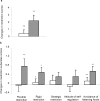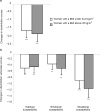Impact of weight reduction on eating behaviors and quality of life: Influence of the obesity degree
- PMID: 20054211
- PMCID: PMC6444470
- DOI: 10.1159/000210692
Impact of weight reduction on eating behaviors and quality of life: Influence of the obesity degree
Abstract
Background: To examine the effects of a short-term weight reducing program on body composition, eating behaviors, and health-related quality of life (HRQL) of sedentary obese women characterized by different obesity degrees.
Methods: 44 women with a BMI under 34.9 kg/m(2) and 39 women with a BMI above 35 kg/m(2) were studied. Fat mass and lean mass (electrical bioimpedance), eating behaviors (Three-Factor Eating Questionnaire), and HRQL (36-item short form, SF-36, questionnaire) were determined before and after weight loss.
Results: Disinhibition and hunger scores and their subscales decreased after weight loss in both groups (0.0001 < p < 0.04). Restriction increased after weight reduction in all women (p = 0.02). Among the five restriction subscales, flexible restriction increased in women with a BMI above 35 kg/m(2) (p = 0.008), whereas rigid restraint and avoidance of fattening foods increased in both groups (0.006 < p < 0.02). SF-36 Mental Component Score increased after weight loss in all women (p < 0.0001).
Conclusion: A 3week weight reducing program changes selected eating behaviors and components of HRQL, irrespective of women's obesity degree. Data suggest that women with a BMI above 35 kg/m(2) could have a better weight control in the long term because of their higher flexible restriction after weight loss when compared to those whose BMI was under 34.9 kg/m(2).
2009 S. Karger AG, Basel.
Figures




Similar articles
-
Effect of weight reduction on quality of life and eating behaviors in obese women.Menopause. 2007 May-Jun;14(3 Pt 1):432-40. doi: 10.1097/gme.0b013e31802e46c2. Menopause. 2007. PMID: 17314737
-
Dietary intake, eating behaviors, and quality of life in women with polycystic ovary syndrome who are trying to conceive.Hum Fertil (Camb). 2015 Mar;18(1):16-21. doi: 10.3109/14647273.2014.922704. Epub 2014 Jun 12. Hum Fertil (Camb). 2015. PMID: 24921163 Clinical Trial.
-
What is the influence of menopausal status on metabolic profile, eating behaviors, and perceived health of obese women after weight reduction?Appl Physiol Nutr Metab. 2008 Oct;33(5):957-65. doi: 10.1139/H08-063. Appl Physiol Nutr Metab. 2008. PMID: 18923571
-
[Simple obesity in children. A study on the role of nutritional factors].Med Wieku Rozwoj. 2006 Jan-Mar;10(1):3-191. Med Wieku Rozwoj. 2006. PMID: 16733288 Review. Polish.
-
Obesity and Eating Disturbance: the Role of TFEQ Restraint and Disinhibition.Curr Obes Rep. 2019 Dec;8(4):363-372. doi: 10.1007/s13679-019-00365-x. Curr Obes Rep. 2019. PMID: 31701348 Free PMC article. Review.
Cited by
-
The Influence of Tofogliflozin on Treatment-Related Quality of Life in Patients with Type 2 Diabetes Mellitus.Diabetes Ther. 2021 Sep;12(9):2499-2515. doi: 10.1007/s13300-021-01125-8. Epub 2021 Aug 6. Diabetes Ther. 2021. PMID: 34357559 Free PMC article.
-
Correlates of health-related quality of life, psychological well-being, and eating self-regulation after successful weight loss maintenance.J Behav Med. 2013 Dec;36(6):601-10. doi: 10.1007/s10865-012-9454-9. Epub 2012 Sep 27. J Behav Med. 2013. PMID: 23015283
-
Validity of the SF-36 in patients with morbid obesity.Obes Facts. 2011;4(5):346-51. doi: 10.1159/000333406. Epub 2011 Oct 21. Obes Facts. 2011. PMID: 22166753 Free PMC article.
-
A small step for obesity but a great leap in the wrong direction for mankind.Obes Facts. 2009;2(2):63-6. doi: 10.1159/000212597. Epub 2009 Apr 20. Obes Facts. 2009. PMID: 20054207 Free PMC article. No abstract available.
-
Do Psychological Factors Help to Reduce Body Mass in Obesity or is it Vice Versa? Selected Psychological Aspects and Effectiveness of the Weight-Loss Program in the Obese Patients.Health Psychol Res. 2013 Mar 21;1(1):e10. doi: 10.4081/hpr.2013.e10. eCollection 2013 Jan 2. Health Psychol Res. 2013. PMID: 26973887 Free PMC article.
References
-
- Enquête épidémiologique nationale sur le surpoids et l'obésité Neuilly-sur-Seine, France, Institut National de la Santé et de la Recherche Médicale (I.N.S.E.E.) Sociétés Françaises d'Enquêtes et de Sondages (S.O.F.R.E.S.) 2006
-
- Rosenbaum M, Leibel RL, Hirsch J. Obesity. N Engl J Med. 1997;337:396–407. - PubMed
-
- Prentice A, Jebb S. Physical activity level and weight control in adults. In: Bouchard C, Physical Activity and Obesity, editor. Champaign: Human, Kinetics; 2000. pp. pp 247–261.
-
- Dionne I, Tremblay A. Human energy and nutrient balance. In: Bouchard C, Physical Activity and Obesity, editor. Champaign: Human Kinetics; 2000. pp. pp 151–179.
-
- Dunn CL, Hannan PJ, Jeffery RW, Sherwood NE, Pronk NP, Boyle R. The comparative and cumulative effects of a dietary restriction and exercise on weight loss. Int J Obes (Lond) 2006;30:112–121. - PubMed

